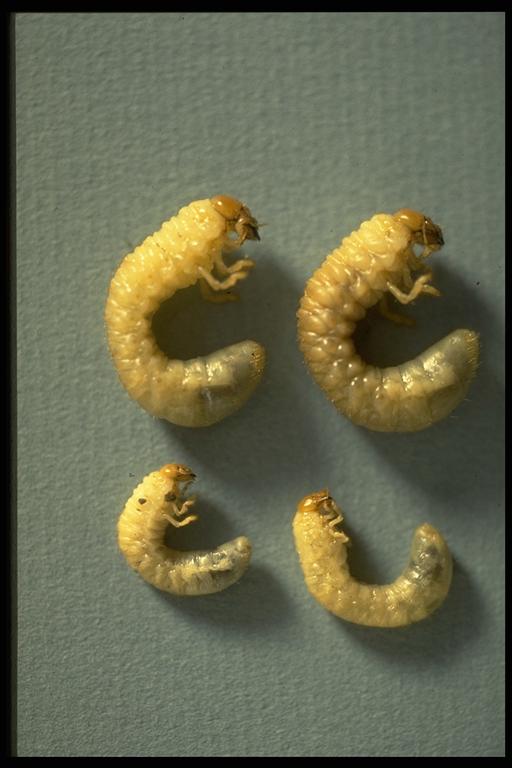
White grubs (Coleoptera: Scarabaeidae), June beetle larvae. Photo by Drees.
Common Name: Grubworm
Scientific Name: Varies
Order: Coleoptera
Description: Adult beetles, commonly referred to as May beetles or Junebugs are ½ to 5/8 inches long, and reddish brown. White grubs are “C”-shaped larvae, up to 1 inch long, with cream-colored bodies and brown head capsules. They have three pairs of legs, one on each of the first three segments behind the head.
There are more than 100 species of scarab beetles from several genera (e.g. Cyclocephala, Phyllophaga and others) in Texas that are considered to be white grubs, May beetles and Junebugs. However, the most common is Phyllophaga crinita. Their biologies are similar, but species differ in distribution, habitat preference, length of life cycle and seasonal occurrence. Other common species include the southern masked chafer, Cyclocephala immaculata (Oliver), and the green June beetle, Cotinis nitida (Linnaeus). One notable member of the family Scarabaeidae, the Japanese beetle, Popillia japonica, introduced into the northeastern United States and migrating west and south, has not been detected in Texas to date.
Life Cycle: Adults begin to emerge in spring. During adult flights large numbers of beetles can be attracted to lights. Peak flights occur in mid to late June in central Texas. Females, less attracted to lights, tunnel 2 to 5 inches into the soil and deposit eggs. In 3 to 4 weeks, small grubs (larvae) hatch from eggs and develop through three stages (instars), with the first two stages lasting about 3 weeks. The last larval stage remains in the soil from the fall through spring. In spring and early summer, white grubs pupate 3 to 6 inches deep in the soil. Adults emerge from pupae in about 3 weeks. There is one generation per year, but in north Texas, development may take two years.
Habitat, Food Source(s), Damage: Mouthparts are for chewing. Phyllophaga crinita is common in Texas turfgrass, particularly bermudagrass, St. Augustinegrass and tall fescue. Feeding of large numbers of grubs causes lawns to turn yellow and die. Severely damaged grass can be “rolled up” like a carpet. Grubs also feed on the roots of weeds, vegetable transplants and ornamental plants. In agriculture, they are important pests of forage, corn, sorghum and sugarcane. Most severe injury to plants is caused by large (third stage or instar) grubs feeding on roots in the fall and spring. White grubs are frequently encountered tilling garden soil or by sifting through soil underneath damaged turfgrass. Adults can be abundant around lights in the spring of the year.
Pest Status: Larval stages eat roots of grasses, vegetable and ornamental plants; Adults can be a nuisance around lights at night in early summer; medically harmless.
For additional information, contact your local Texas A&M AgriLife Extension Service agent or search for other state Extension offices.
Literature: Hamman et al. 1985. Drees et al. 1994.